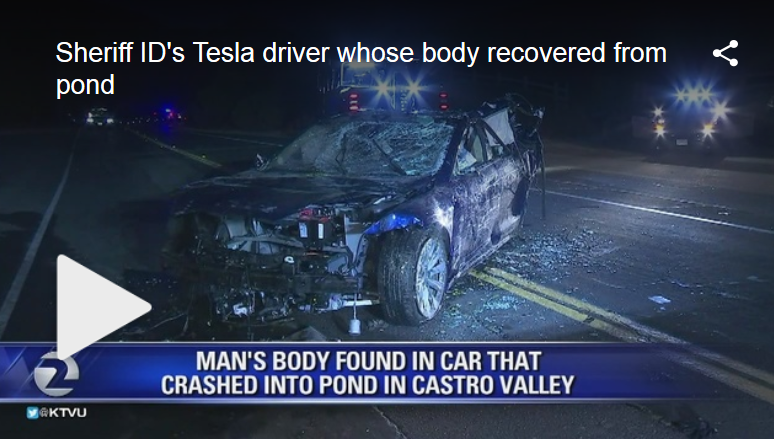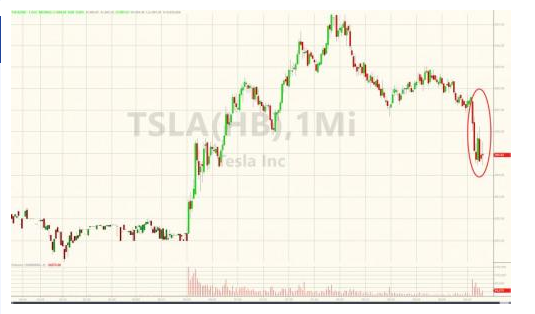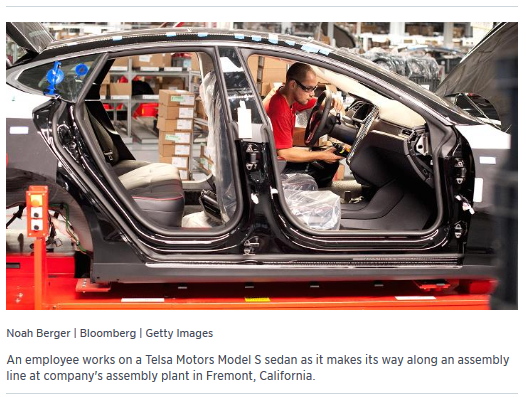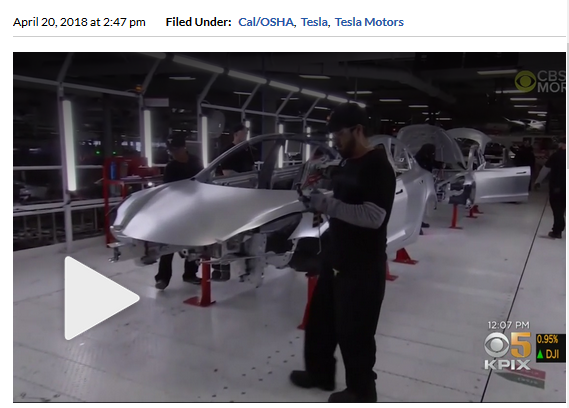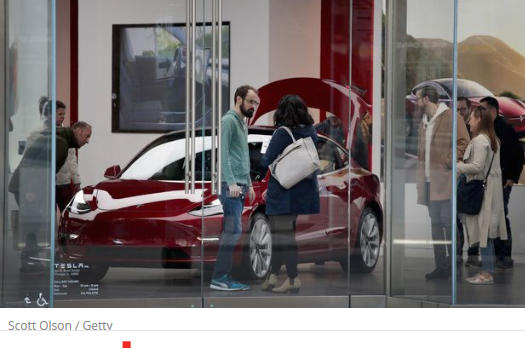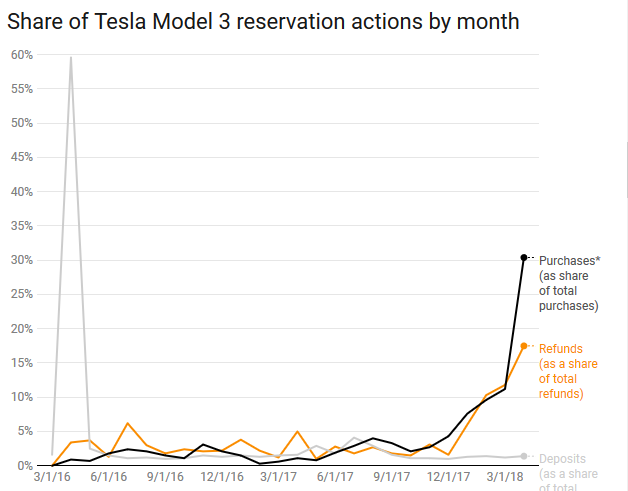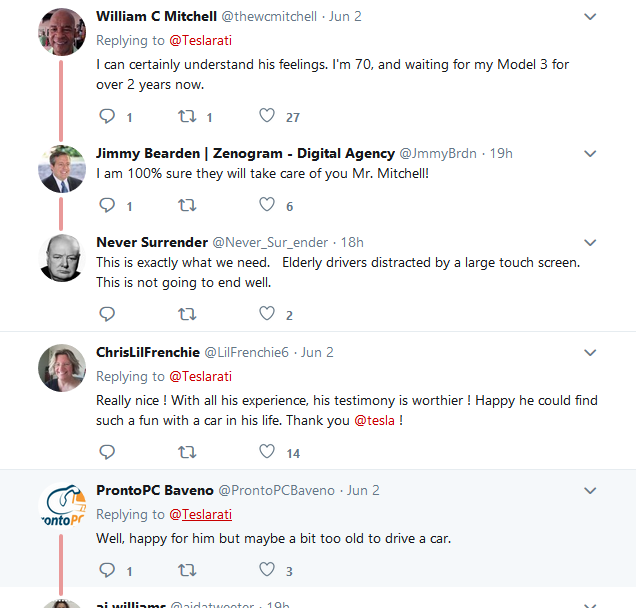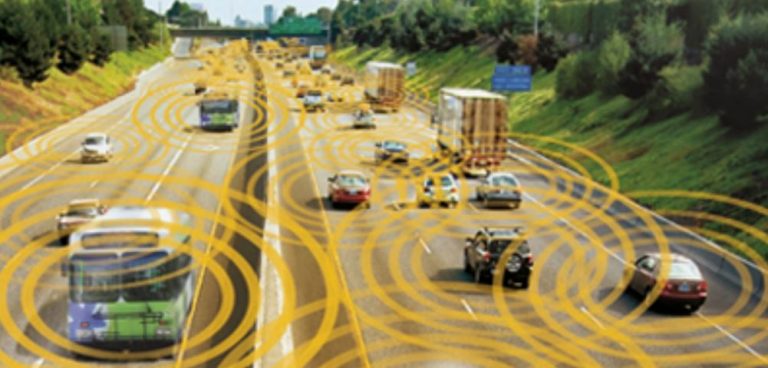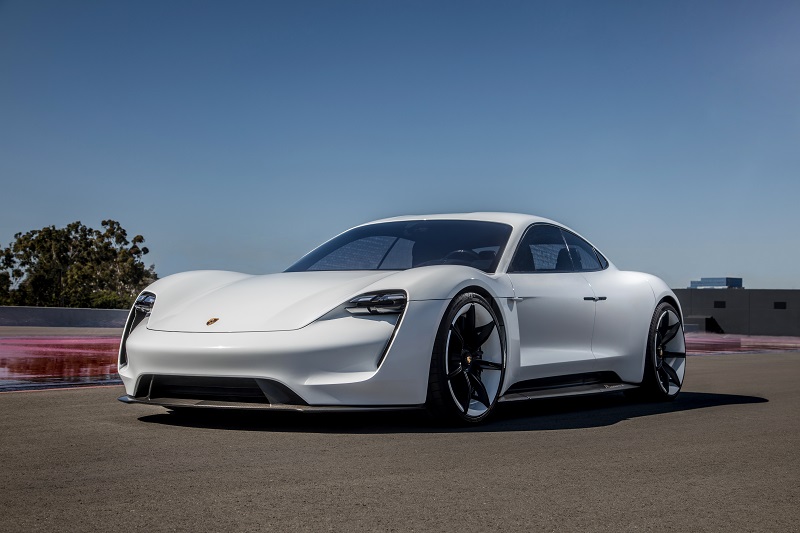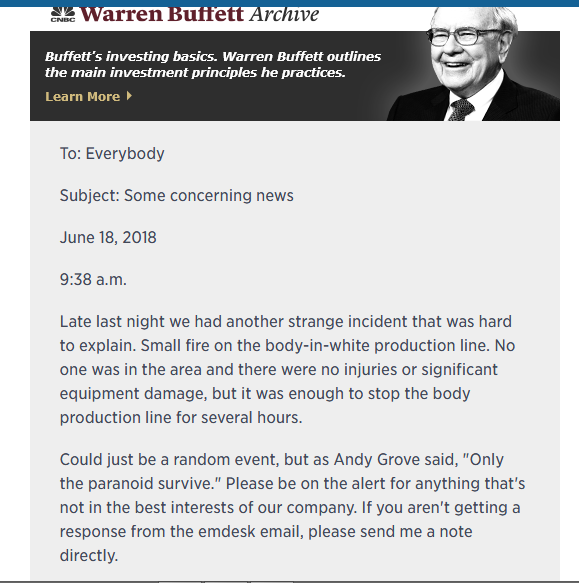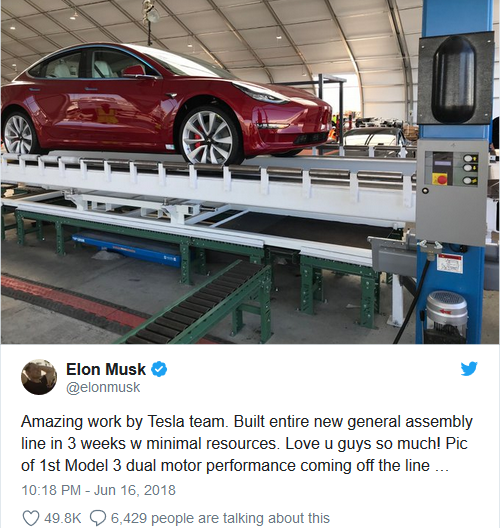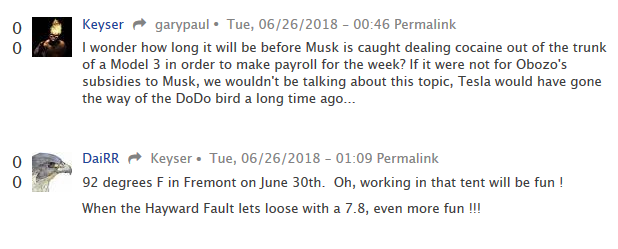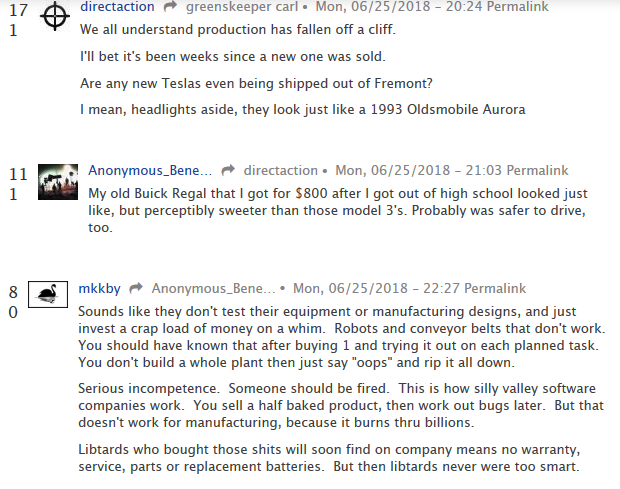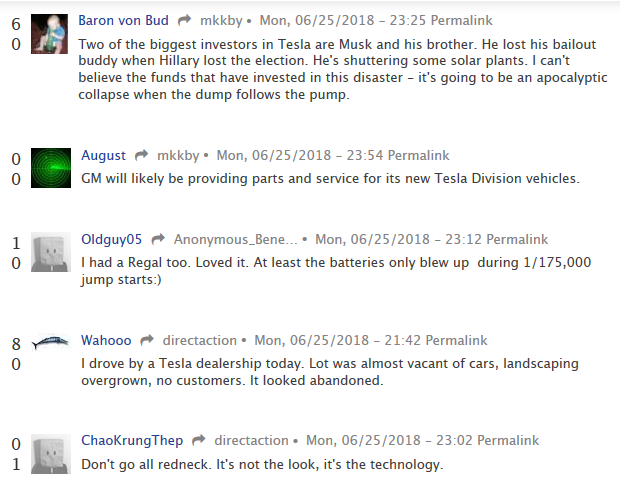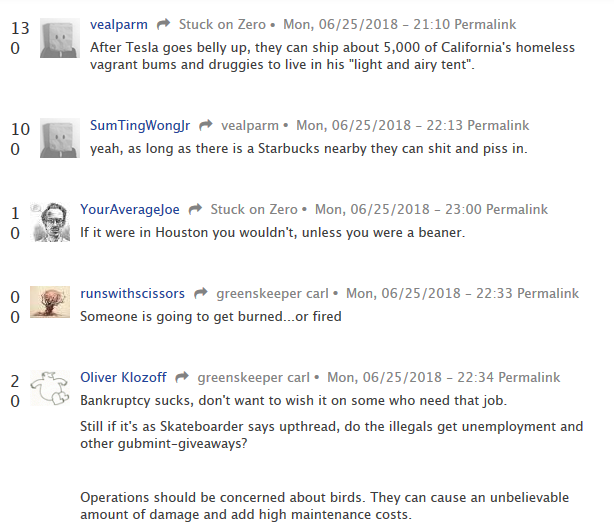Tesla workers say factory paint shop has had multiple fires, causing more problems than Tesla let on 
Published 2 Hours Ago
https://www.cnbc.com/2018/06/01/tesla-factory-paint-shop-fires-worse-than-revealed-workers.html
Employees say Tesla has experienced at least four fires in its paint shop in the last four years, and that sprinklers and air filtration systems are clogged with paint.
Fires in the paint shop contributed to sluggish Model 3 production, some employees say, and fumes there are leaving them concerned about their health.
Tesla has had at least four fires in the paint shop at its
Fremont, California, factory since 2014, according to five people familiar with operations at that plant.
One
previously reported fire, in April, was serious enough to stop Model 3 production for multiple shifts that week, these people said. Another fire took place in January 2016 and caused at least a day of suspended vehicle production. Both fires damaged expensive equipment.
These people blamed the fires in part on improper cleaning, maintenance and insufficient training for new employees in the face of high pressure to meet production goals. Two current employees said they were concerned about their health because of fire hazards and poor air quality. All the people agreed that the April fire contributed to slowing down Model 3 production.
A Tesla spokesperson denied that the April fire was "significant" or had any impact on Model 3 production, and said:
"In recent months, we have further enhanced the safety and efficiency of our paint shop, including significant upgrades to equipment, as well as an extensive maintenance effort involving cleaning and calibration. In order to protect the health of our employees, we also conduct regular air monitoring and have proper ventilation and personal protective equipment for everyone who works in the paint shop."
Tesla's future as a mass-market carmaker hinges on efficient, high volume production of the Model 3, the company's lowest-priced offering so far. When
Tesla unveiled the Model 3 in 2016, CEO
Elon Musk said it would be able to produce 100,000 to 200,000 Model 3 cars by the end of 2017 with a base price of $35,000.
Instead, Tesla produced just 2,685 Model 3s in total for all of 2017.
Tesla also missed its goal of producing 2,500 Model 3s per week by March 31, 2018. So far, the company has sold only premium versions of the Model 3, which cost $44,000 to $78,000.
Paint shop issues are still hampering Tesla's progress with Model 3 production, according to current employees and other people familiar with Tesla's paint shop. They requested anonymity because they have not been authorized to speak to the media.
April fire
When a paint shop fire
halted vehicle production around 7 a.m. on April 3, a Tesla spokesperson said the fire was "small" and extinguished by internal teams in a matter of seconds.
But employees told CNBC the fire was significant enough to stop work for at least a full shift on that day. The shop was also shut down for at least one more shift two days later. It also forced Tesla to decommission two burnt sprayer robots that they estimated were worth over $1 million.
The fire happened just after the company's head of vehicle engineering, Doug Field, who is
now on leave, sent out an e-mail encouraging employees to "
prove the haters wrong." In that spirit, and under management's direction, paint shop crews worked on.
The week of the fire, according to two employees and two other people familiar with Tesla's Fremont factory, Musk showed up to assess damage to the paint shop. The fire had burnt an entire zone dedicated to painting Model 3s.
Rather than suspending operations immediately, Musk and others encouraged teams to fix what they could and push through.
Some Model 3 parts, including B-pillars and chassis components, which had been in the paint shop at the time, were moved into a containment area, visually inspected and put back into production, rather than being scrapped or further tested for damages, employees said.
Tesla emphasized that no damaged parts were used in new vehicle production.
Engineers scrambled to repurpose equipment in the paint shop that week so that robots could be used to put primer on both the interior and exterior surfaces of Model 3 vehicles. Before the fire, separate robots handled interior and exterior primer application.
Tesla handled the April 3 fire with its own internal brigade. It did not report it to the Fremont Fire Department, a spokesperson for the department confirmed.
However, a citizen did call after seeing reports about the fire on social media that day, the fire department spokesperson said. Tesla security greeted a fire department battalion chief who went to investigate and said the department had no internal reports of fire at the facility, the spokesperson said. The chief toured the exterior of the Fremont factory looking for signs of fire, and seeing nothing but a "cloud formation" outside, left without going inside, according to the spokesperson.
A week and a half later, Tesla announced it was
shutting down its Fremont factory operations temporarily to make some improvements. (Tesla also shut down its factory for a week in May for planned upgrades.)
Improper maintenance and production pressure reported
Fires like these are not common in auto manufacturing. It is especially uncommon for a plant to have multiple fires in a paint shop.
According to the most recent available data from the
National Fire Protection Association, local fire departments respond to 190 fires per year on average in maintenance or paint shop areas of factories and processing facilities. That is just 4 percent of fires that occur in all of manufacturing.
The rate of paint-shop fires in auto plants is far lower than that, says Jason Reason, a former OSHA officer and senior vice president of safety and health at
Lewellyn Technology in Indiana.
"For the most part, corporations know how to control fire hazards associated with spraying operations, and work to establish a safety culture," said Reason. "If you're having multiple fires, you really need to audit your paint shop and make sure it never happens again, even if that means redesigning the whole thing."
A spokesperson for GM manufacturing, Dan Flores, noted: "At GM, we would consider a fire in a paint shop an extremely rare occurrence — that's because our paint shops operate in a very controlled manner."
Two Tesla employees say that vehicle production goals have been the highest priority in recent months, sometimes at the expense of fire and environmental considerations. They said, for example, that months before the April fire, the sprinkler heads were clogged and coated at least an inch thick of paint and clear-coat. Filters below the paint booths and exhaust systems that clean and carry air into and out of the building were also visibly coated, they added.
A former paint shop employee said associates there are given minimal training — just what they need to meet OSHA safety requirements — before they are put to work on jobs that need more specialized skills. The result is that while Tesla has invested in state-of-the-art equipment, these inexperienced employees don't follow best practices. The result: botched jobs and a potentially unsafe environment, according to the former employee, who spoke on condition of anonymity.
Workers are hopeful things may soon change. Since early April, Tesla has replaced some sprinkler heads, and put out a request for quotes on new air filtration equipment.
On a
tense earnings call in May, Musk plainly acknowledged that the paint shop at Tesla's Fremont factory poses a risk to mass-production of the Model 3 electric sedan.
The CEO said: "General assembly is probably our biggest risk, and I'm refocusing personally on that a lot in the next — in the coming month. And then our paint shop is maybe the second biggest risk after general assembly."
On the same call, he sought to assure analysts "[It's] not like you need brain surgery to get these things right."
Here is Tesla's full statement to CNBC:
"In recent months, we have further enhanced the safety and efficiency of our paint shop, including significant upgrades to equipment, as well as an extensive maintenance effort involving cleaning and calibration. In order to protect the health of our employees, we also conduct regular air monitoring and have proper ventilation and personal protective equipment for everyone who works in the paint shop.
As was previously reported, we experienced a fire in our paint shop in April, though it was quickly extinguished and did not materially impact production. As part of this event, we immediately mobilized an internal team to learn from the event and we're confident that the steps we're taking will prevent similar events from occurring in the future. We put a lot of effort into this endeavor and are very proud of this team's work."
The Truth About the Tesla Semi Electric Truck | Auto Expert John Cadogan | Austral
AutoExpertTV Published on Dec 18, 2017 / 16:59
The Tesla truck - the much-hyped Semi - is heavy-hauling electrified pie in the sky.
Another Cal/OSHA Tesla Investigation After Factory Worker Breaks Jaw
FREMONT (CBS SF) – As Tesla faces questions over safety at the Fremont factory, state officials are investigating an incident where a subcontractor suffered a broken jaw.
Bloomberg News reported Friday that the California Division of Occupational Safety and Health launched an investigation on April 12 into the incident.
Cal/OSHA spokesperson Erika Monterroza said the 30-year-old worker was hospitalized when he was struck by a skid carrier, suffering a broken jaw and a laceration to his face.
The maker of electric cars told Bloomberg that they are cooperating with the investigation.
Earlier this week, Cal/OSHA
announced a separate investigation into Tesla over the reporting of worker injuries at the factory.
A report by the Center for Investigative Reporting accused Tesla of undercounting worker injuries on official injury reports, by listing injuries in several cases as “personal medical” cases unrelated to work.
Tesla has come out strongly against the report, claiming it was “an ideologically motivated attack” and that the center was working with supporters of a plan to unionize the plant.
The automaker is facing increased scrutiny on other fronts, including
production delays on the mass market Model 3 sedan, and
a deadly crash involving a Model X SUV on Autopilot in Mountain View last month.
May 16, 2016
Step Aside Uber, Tesla: Waymo Will Launch World's First "Self-Driving Transportation Service" This Year
Tyler Durden Fri, 06/01/2018 - 16:51
In the race for autonomous driving and "autonomous driving as a service," Google's Waymo is lapping its competitors including Uber and Tesla.
According to media
reports, Waymo is going to be launching 62,000 Chrysler Pacifica minivans, which it will be adding to its fleet in anticipation of launching its self driving transportation service as soon as this year. These minivans will be equipped with the company's autonomous driving software, which puts Waymo ahead of companies like Uber and Tesla, both of which are also working on pushing into the new, burgeoning self-driving industry
The push to launch these vans comes as a result of a partnership with Chrysler and as the company looks to create an autonomous ride sharing program that can be hailed with an app. The Daily Mail
reports:
Google-owned Waymo is adding as many as 62,000 Fiat Chrysler minivans to its autonomous fleet in an expanded collaboration announced by the companies on Thursday. Delivery of the Chrysler Pacifica minivans was expected to begin later this year, with the automaker also exploring the potential to build Waymo technology into a self-driving car it might add to its model line-up for consumers.
'FCA is committed to bringing self-driving technology to our customers in a manner that is safe, efficient and realistic,' chief executive officer Sergio Marchionne said. 'Strategic partnerships, such as the one we have with Waymo, will help to drive innovative technology to the forefront.'
The
article then notes that Waymo will likely be the first company, before Uber and Tesla,
to launch the first truly self-driving vehicle later this year, and that Uber and Waymo could eventually wind up working together to get Waymo's software into Uber vehicles:
Waymo plans to launch the 'world's first self-driving transportation service' this year, with people able to summon rides from driverless vehicles using a smartphone application. The announcement came a day after Uber chief executive Dara Khosrowshahi reportedly said at a Code technology conference that the company is speaking with Waymo about putting its cars to work at the smartphone-summoned ride service.
Uber early this year negotiated a settlement with Waymo over trade secrets purportedly purloined from the self-driving unit of Google-parent Alphabet. Uber suspended its own autonomous car testing in April after an accident that killed a woman pushing a bicycle in a street in Arizona.
Waymo CEO John Krafcik has publicly contended that the fatal accident involving a self-driving Uber car would not have occurred with his company's technology.
In addition to Waymo working on its partnership with Chrysler, the company is also collaborating with Jaguar Land Rover, which is said to be toying with the idea of launching a higher-end, self-driving electric car service (just in case not everyone wants to be seen being ushered around in a Chrysler Pacifica):
Fiat and Waymo first announced a self-driving car partnership two years ago, and said that engineers from their companies have been working together since then. Fiat has delivered 600 Pacifica Hybrid minivans to Waymo so far, the companies said. Earlier this year the companies said 'thousands' more would be added.
Waymo and Jaguar Land Rover in March announced they have joined forces on a posh, self-driving electric car tailored for a ride-hailing service run by the Google-owned firm.
...
Waymo and Jaguar said they aim to develop a 'premium self-driving electric vehicle' based on a new I-PACE model.
The news about Waymo's surprising progress comes in the wake of recent disturbing headlines from Tesla and Uber regarding their cars‘ self driving capabilities. Tesla has been dealing with the media fallout from several deadly accidents linked to the the "autopilot", while Uber has reportedly suspended its self-driving tests after a woman was killed in Arizona some months back after being stuck by an autonomous vehicle.
Waymo has so far been luciky to sidestep any bad press and has been silently executing on this partnership and pushing its software forward.
Meanwhile, the great race to be the first to roll out a truly self-driving vehicles is only accelerating, and just yesterday SoftBank
announced that it would make a $2.25 billion investment into General Motors' autonomous driving technology. On Thursday morning, tech-investing giant SoftBank Vision Fund announced it would
invest $2.25 billion in General Motors Co.’s driverless-car unit valuing it at $11.5 billion, creating a new player in the ongoing fierce battle between tech companies and startups to become the first to commercialize autonomous vehicles.
The deal will provide not only a major financial backer - a la what Uber tried to do with Warren Buffett and failed - but will also "afford GM increased flexibility with respect to capital allocation" as it plows more money into developing a network of autonomous ride-share vehicles, targeted for sometime next year, GM said.
Opening the Cruise subsidiary to SoftBank’s giant fund allows it to access capital that investors have been reluctant to grant the 110-year-old auto maker. GM will retain an 80.4% stake in GM Cruise and invest $1.1 billion in the business.
During a press conference Thursday morning, GM Chief Executive Mary Barra called it a “landmark” investment that gives GM Cruise the capital it needs to get its driverless-car business to market.
With the Softbank investment and the news that Waymo is working with Chrysler and could be working with both Uber and Jaguar, there is no doubt that the race for full autonomous has now officially been put into high gear.





